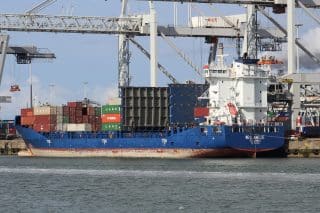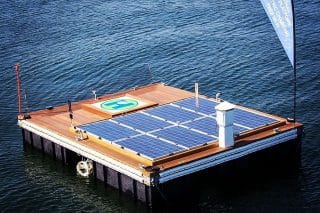Hydrofoil, which lifts the hull out of the water, was popular in the ’60s and ’70s, mostly with successful military and commercial passenger boats. Although hydrofoil can reduce both the effect of waves and the drag at high speed, hydrofoils are vulnerable to objects in the water and expensive to build.
Foilborne operations are limited as wave height exceeds the hydrofoil’s strut length. These have caused a steady decline in interest and popularity, though in the past several years, the boating industry has seen new hydrofoil projects.
Foilborne
A hydrofoil boat uses lifting elements (foils) to create an upward force, which raises the hull out of the water (takeoff). The lifting force is a result of a pressure difference in the flow field above and beneath the foils. This principle is comparable to wings (aerofoils) of an aircraft.
Yet hydrofoils only generate lift when they move through water—in order to take off and overcome the total drag, extra power and an efficient hull is needed. With the hull out of the water and the foils submerged, the hydrofoil boat is “foilborne.” From then, the foils only need to keep the boat in a good seakeeping and steerable condition.
Foils are most commonly in a T- or L-shape, and the most common system is the fully submerged type, which is more stable and less a subject to the effects of sea waves.
Up to 65 knots
The French sailing hydrofoil Hydroptère is a state-of-the-art vessel that combines leading technology from both the aeronautic and marine industries. The project started with a childhood dream from Alain Thébault.
In 2009 Hydroptère broke the outright sailboat speed world record of more than 51 knots in just 30 knots of wind. Today this record stands at 65 knots by the VSR2 Sailrocket.
In the America’s Cup, hydrofoil is the established standard, where catamarans like an AC72 powered by a tall wing sail are able to hydrofoil at speeds of almost three times the wind speed.
These hydrofoils also exist in smaller sizes, with hydrofoil boards to surf, kite or wake.
On large power boats
In the motor yacht business, some new projects are also focused on hydrofoil. The Sunreef Yachts naval architects team decided to develop a system of retractable hydrofoils that will enable their luxury vessels to attain a maximum speed of 70 knots and fly over the surface of the water.
A retractable hydrofoil system makes all sorts of weather conditions possible, from smaller waves to rough seas. Their first model fitted with hydrofoils will be the 40 Sunreef Hydrofoil, a 40-foot luxury motor catamaran—the first hydrofoil in the luxury catamaran industry.
Foil-based PWC
Perhaps the most eye-catching, futuristic hydrofoil is the Quadrofoil. The Q2 is a small PWC two-seater that’s electric powered and designed to have an overall low cost of ownership. When the watercraft is airborne, the focus is on its acceleration and power steering, making for a smooth ride on the water. The batteries offer a range of almost 54 nautical miles.
[youtube url=”https://youtu.be/ooAAnZIgj8o” autoplay=”no”]
We interviewed Simon Pivec, director of R&D, who believes that hydrofoil technology represents the future of boating.
NauticExpo e-Magazine: Why did you choose foils?
Simon Pivec: Quadrofoil wanted to design the next generation of watercrafts that would follow five basic guidelines: eco-friendliness, high energy efficiency, state-of-the art design, advanced performance and driving dynamics and low total cost of ownership. Hydrofoils were the optimum choice that would deliver just that.
NauticExpo e-Magazine: You developed a specific steering technology for your Quadrofoil.
Simon Pivec: In the past, hydrofoils had a big disadvantage. When they are fixed/rigid they are only suitable for driving straight forward. So their maneuverability was limited due to the hydrodynamics of fixed foils. We designed a patented steering system that turns all four hydrofoils and follows the turning radius without reducing speed or stability. Thanks to this technology, you can drive/fly in almost all conditions.
NauticExpo e-Magazine: What did you learn from hydrofoil’s history?
Simon Pivec: Science applied in the Quadrofoil project is a result of experience and knowledge gained through our projects from the past. We have also studied literature and past research, mostly learning from mistakes that have been made by other inventors and figuring out why hydrofoils have not evolved in past 100 years. But at the end, we rely and focus also on testing each and every part of the vessel.
More on hydrofoils in NauticExpo e-Magazine issue#2








